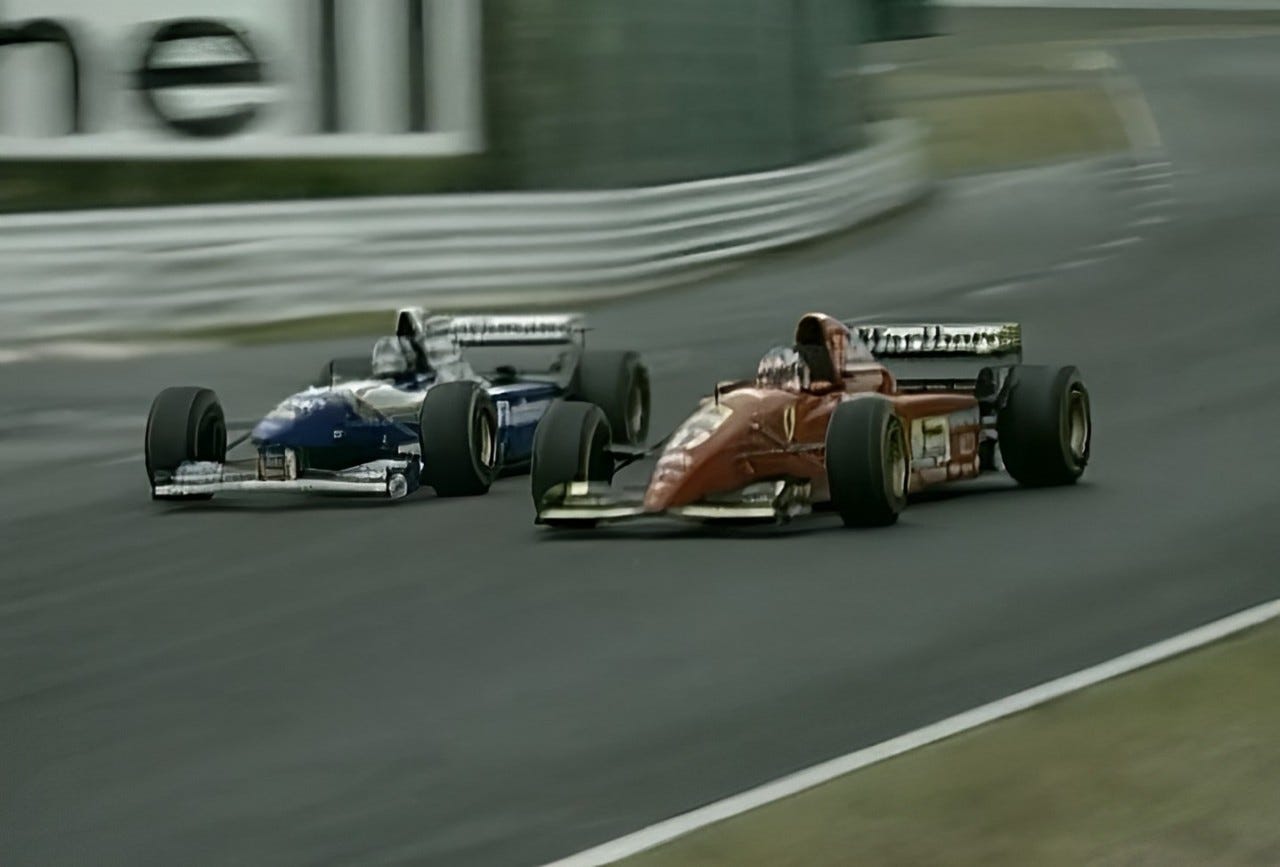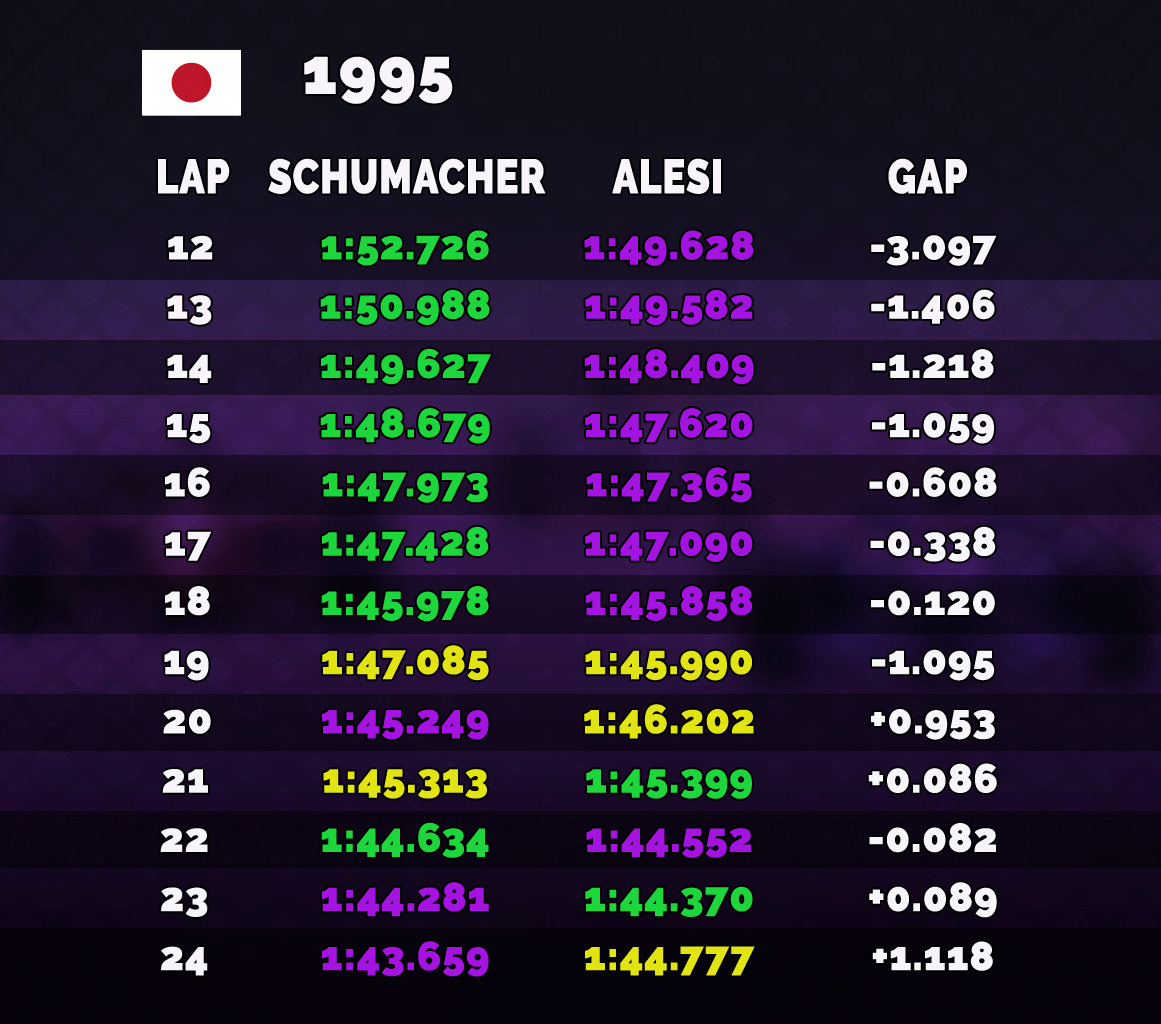Usually, in Formula 1, the greatest praise is reserved for performances that ended in a victory. Understandably. After all the ultimate goal of racing is winning.
But throughout the history of the sport there have been drives that, even though they did not achieve said goal, still enjoy the highest recognition, like Senna’s 2nd place in Monaco in 1984 and Schumacher’s identical result in the Spanish Grand Prix ten years later. They didn’t win, but what they did in said races has been exceptional enough to be elevated above many of their own victories.
Jean Alesi won only one race in his Formula 1 career: the 1995 Canadian Grand Prix. To make it even more memorable he achieved it on his birthday, which hadn’t happened before and hasn’t happened since. But the aforementioned victory, in the eyes of many, lies in the long shadows of his greatest drives. Like the one in the penultimate round of the 1995 season, held at Suzuka. A fitting place as the circuit is often referred to as a real drivers track.
Alesi in a scarlet Ferrari started from the front row, right next to the pole sitter, Michael Schumacher in a blue Benetton, who had clinched his second championship in the previous race. The track was damp but it wasn’t raining. Today teams put intermediates on their cars in such conditions, but the 1995 grid didn’t have them at their disposal. (Inters were in use two years later, so I guess 1997 was the year they were introduced.) Everyone was on wets.
The front row starters retained their positions going into the first corner. Schumacher and Alesi were comfortably pulling away from the rest of the pack by around 1 second per lap, but such an order didn’t last long. The French Sicilian received a 10 second stop and go penalty for jumping the start. But whether he actually had done that is questionable.
In 1995 the FIA introduced a new system of policing race starts. The sensors were put in the track and they measured whether a car moved before the lights went off. Key word: moved… not necessarily forward. The system resulted in so many jump start penalties (for example in Monaco 5 or 6 drivers got it), which lead to a suspicion that the sensors even rolling backwards recognize as breaking the rules.
Alesi served the penalty on lap 5 and dropped to 10th, around 30 seconds behind the leader. The Ferrari driver boxed two laps later for slicks. On his way to the pits, he casually overtook Johnny Herbert on the inside of 130R. He came out in 15th place. On the out lap he quickly caught up the Minardi driven by Pedro Lamy. The French Sicilian tried to pass the backmarker around the outside of the right hander leading to the main straight. Lamy didn’t see the scarlet Ferrari alongside him and Alesi had to take the avoiding action. He ended on the grass, spun and rejoined. He overtook the Minardi in Spoon on the next lap, which he finished in 9th position. And set the fastest time. Nearly 7 seconds faster than the leader.
It quickly became obvious to the teams that slicks are the way to go. So majority of drivers ahead of Alesi boxed and gifted him positions and clean air. He instantly made good use of it by setting another fastest lap, which was 5 seconds faster than the next quickest time set by Rubens Barrichello.
Alesi was 6th, but not for long. On the 11th lap he leapfrogged David Coulthard and overtook Damon Hill, who had pitted for slicks the lap before, in a swashbuckling fashion around the outside of the chicane.
On lap 12 Hakkinen and Irvine pitted and Alesi had only the blue Benetton in front of him. Schumacher’s net lead had been around 30 seconds, but it took Alesi only 3 laps to cut it to 7. Such was the power of tire advantage. The German had pitted on lap 11. Now he also had slicks put on, but they were not as warm as Alesi’s. The Frenchman immediately took advantage of it.
He was catching Schumacher hand over fist. He set 7 consecutive fastest laps and reduced the Benetton’s driver lead from nearly 7 seconds to only 1. The German was responding with personal bests but it was not enough. Purple beats green. Schumacher finally got the former on lap 20 and gained nearly a full second.
Lap 21 was the only one in the stretch showed in the graph in which neither of the two set the fastest lap. It temporarily belonged to David Coulthard.
The Ferrari driver got purple the next lap. Schumacher responded with 2 consecutive fastest laps. The tires on his car were up to temperature and ready to hold off the charging Ferrari. But it wasn’t the German’s pace that ended the duel. It was the driveshaft in the Frenchman’s car.
Alesi had to retire in what he himself described as “race of his life.” All of his heroics were in vain. The question whether he could have overtaken Schumacher and won or not, unfortunately, will forever stay in the realm of speculations.
Undoubtedly it was an exceptional performance. Alesi was able to immediately warm up the slicks and fly on the semi dump track. No one could do that as fast. Not even Gerhard Berger in the same machinery. Alesi put the tires on and they were hot like pizza out of the oven. They were in love with his full send, full commitment driving style.
As undoubtedly great as Alesi’s performance was, it was possible not only because of his skills. The tires also played a role. Full wets in those years had a narrow operating window. They worked well when there was a lot water on a track. Once a circuit became on the cusp between damp and dry, they quickly overheated and lost performance. Hence the humongous difference in lap times. Bigger than a difference between inters and slicks in modern Formula 1.
That’s not to complain or depreciate, but to simply state the obvious: when there are only two types of tires suited to opposite conditions, switching from wets to slicks on a drying track back then was in general much more rewarding than today.
Last year even Pirelli, the sole tire supplier, agreed that wets are useless. Maybe we the FIA should made them useful by banning inters? This hot take constantly pops out in my head whenever I think of Alesi’s heroics at Suzuka.





